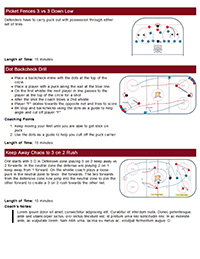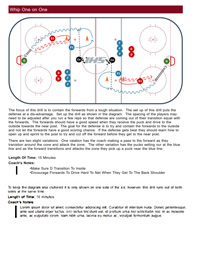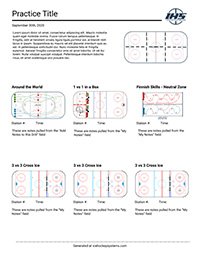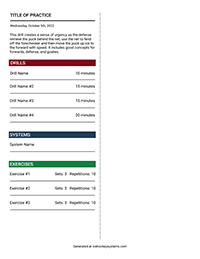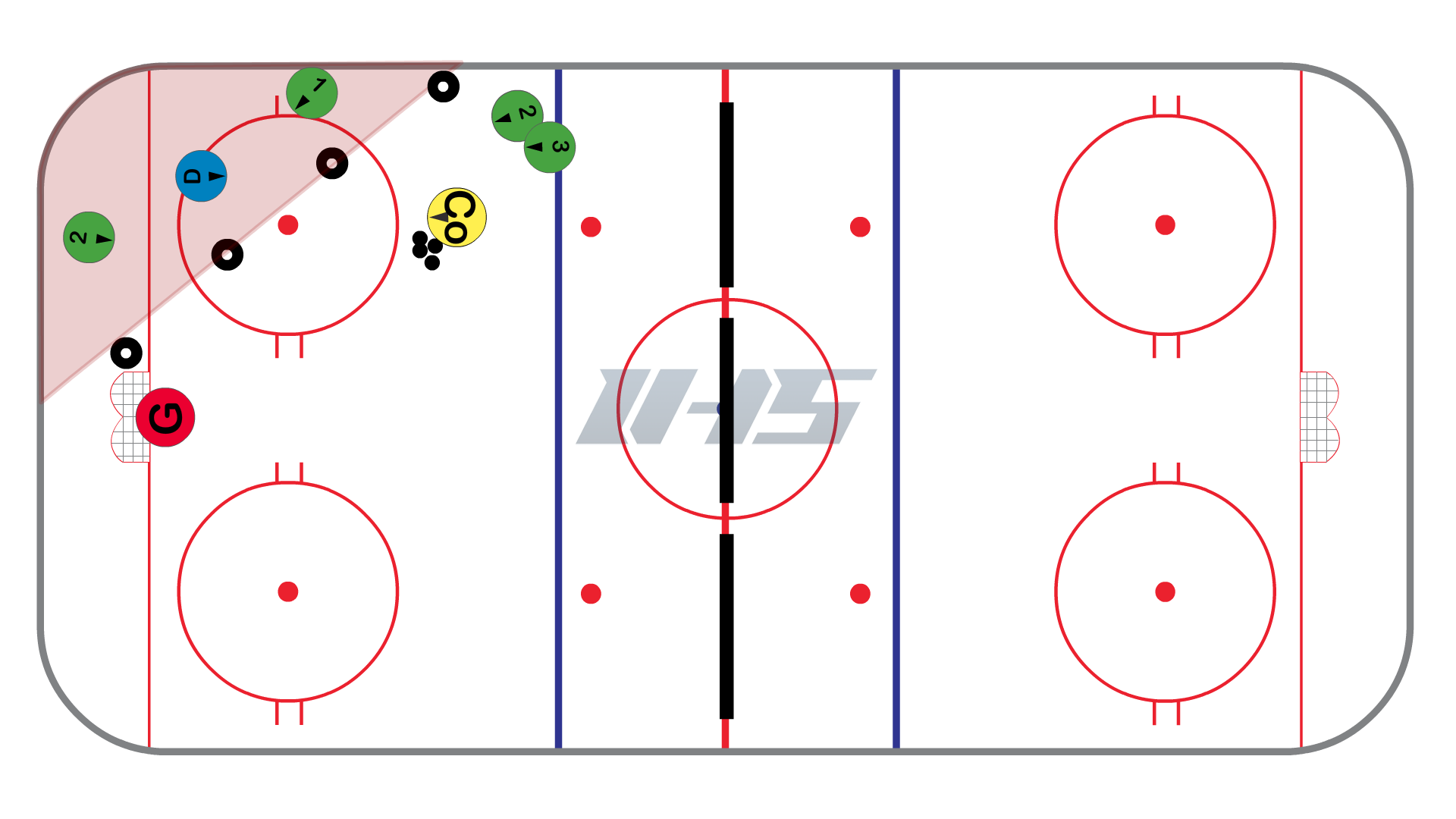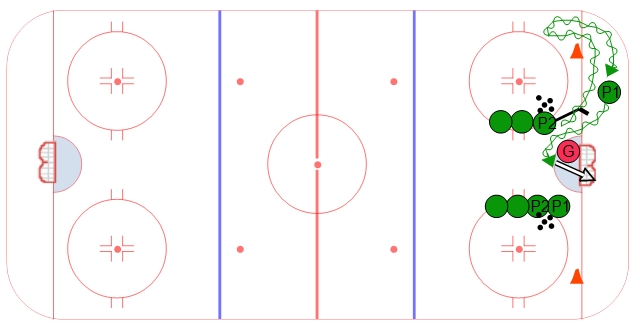
U14 - Down Low Play & Wall Play Skills
U14 - Down Low Play & Wall Play Skills

Practice Notes
The focus areas in this practice center around wall play skills and offensive/defensive play below the tops of the circles. 80% of the game of hockey is played along the walls. This practices emphasizes the skating, puckhandling and decision making skills that improve the ability to improve puck conditions and make plays in tight areas.
Practice Layout
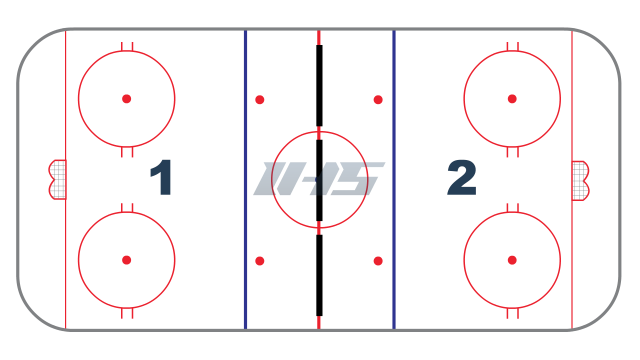
Exposing vs. Protecting the Puck
In this video Ben Eaves demonstrates the importance of protecting the puck vs. exposing it. Use your body, hips, and stick to surround and protect the puck until you are ready to make a play. Expose the puck once your are ready to make a play.
Talk to the players about exposing versus protecting the puck and the associated skills.
Puck Protection - Surround Puck
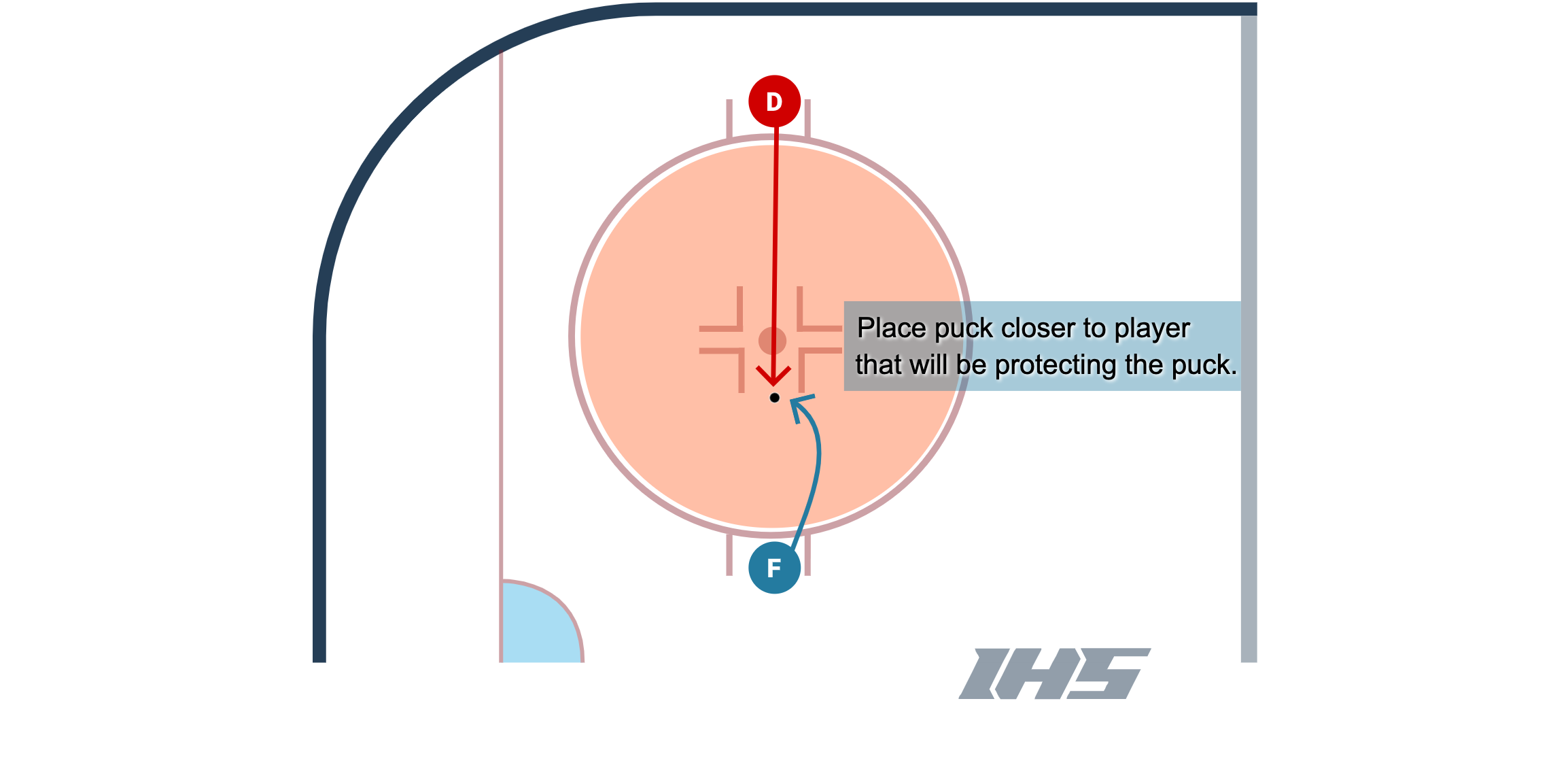
This puck protection drill can be done in one of the circles. To set it up place two players on opposite sides of the circle facing each other. One player will be designated as the puck protector. Place the puck closer to the puck protector to give them a slight advantage. On the whistle both players battle for the puck. As you see in the video the puck protector should take care the defender's stick and use their body to surround the puck. The puck protector works to keep the puck in the circle. Allow the players to battle until the puck protector looses possession of the puck.
Puck Retrieval Along The Boards
Retrieving the puck along the boards happens countless times throughout the course of the game and it is where many 1 on 1 battles are won or lost. When players collect the puck off of the boards is not usually a highlight-reel play, but if they are able to learn a few simple concepts, they will be able to impact the flow of the game. These concepts will allow players to create space so they have time to make a play. Plus, with an evasive move, they will be much harder to hit!
In the video above, Coach Ben Eaves discusses two major concepts when retrieving a puck:
- Look Over Your Shoulder: This is concept # 1 because it is most important. Looking over your shoulder will allow you to know if you have time, or need to make an evasive move to create time.
- Retrieve The Puck At An Angle: This will allow you to keep your speed up while you are going to get the puck. Plus it is much safer than going head-on into the boards.
The video gives you three options to practice:
- Option 1: If you look over your shoulder and see you have time, continue skating full speed at an angle to pick up the puck and bring it up ice.
- Option 2: If you look over your shoulder and you see you have pressure, skate at an angle but use your upper body to deceive the defending team and quickly turn up ice.
- Option 3: If you look over your shoulder and you see someone right on you, point your feet (which will point your body) one way and quickly move your hips and move your feet in the opposite direction to evade the defender. This is usually the most effective but will take time and good edgework to get comfortable with. Note: When you get comfortable with Option 3, combine the lower body fakes with upper body fakes to really throw off a defender!
Bonus: Watch the Toronto Maple Leafs practice their puck retrievals and forchecking in this fun 1 on 1 battle.
Wall Retrieval Station
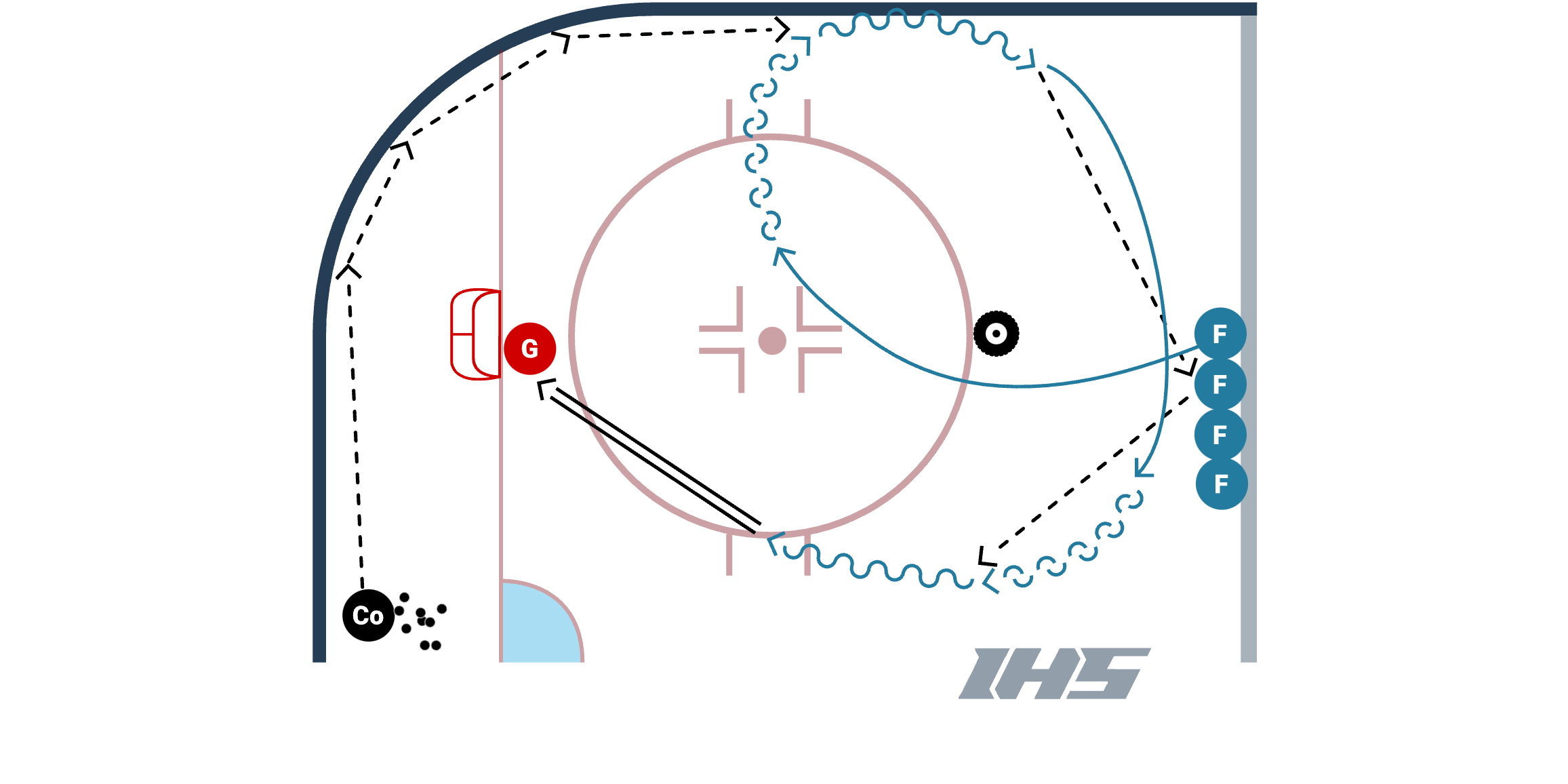
The goal of this drill is to get players a more comfortable handing pucks along the wall and provides a situation you can use to teach them various techniques.
Setup:
- This station can be set up to use half of one of the zones.
- Pucks should be set behind the goal crease in the middle of the ice with the coach or other player. If you are using both sides then two coaches can share the pucks and each will rim the puck to opposite sides.
- A tire or cone can be placed inline with the dots at around the top of the circles.
- Players are lined up along the blue line with the first player inline with the dots.
- Player 1 will skate up around the tire towards the wall, open up to face the puck as it is rimmed around. The players should time it so they are skating up ice as they gather the puck.
- Once they gather the puck they will make a pass to the next player in line, go around the tire, open up and call for the puck, then receive the puck back to take a shot on net.
Coaching Points:
- Encourage players to move their feet and keep their heads up as they gather the puck along the boards.
- Players should look at the point to see where the defense is. You can do this with no defence just to get them in the habit of looking at the point, or you can have the defence add pressure so the drill can be variable.
- Players should get to the wall.
- After they get the puck, they should skate away from the wall so they have space to play to the center or to the boards.
Variations:
- You can add a defender playing the point that occasionally jumps in, which will require the forwards to be more aware of the situation.
- You can add obstacles that the player needs to pass through when they pass to the point.
- You can require the player to shoot in stride, change their shot angle or practice their one-timer when they are shooting on net.
- You can make this drill half ice so more skating and longer passes are required.
- You can have the forward go to the net and have the defense take a shot so the forward has to tip or deflect it.
Royal Puck Protection Down Low
Here is a follow up to the previous Royal Puck Protection Drill and is a good one to use in the same practice session. The key focus of this hockey drill is on protecting the puck, moving the feet, and in this variation moving out from below the goal line for a scoring opportunity.
To set up the drill form two lines just off to the side of the crease and a few feet off of the goal line. The first player in line takes a puck and skates along the boards outisde the tire then starts up the wall. After a stride or two up the wall they do a control turn with the puck and go back around the tire. With the puck they will attack the net from below the goal line yet in front of the line. The second player in line will use their stick to force the puck carrier to protect the puck. The puck carrier also has to try and protect the puck from the goalies.
Encourage players to work on using their eyes to show deception (faking that they're looking to pass to the point or the middle) before cutting back each time.
Progress to adding in an option for a pass to the slot.
Double Gates Activation Game
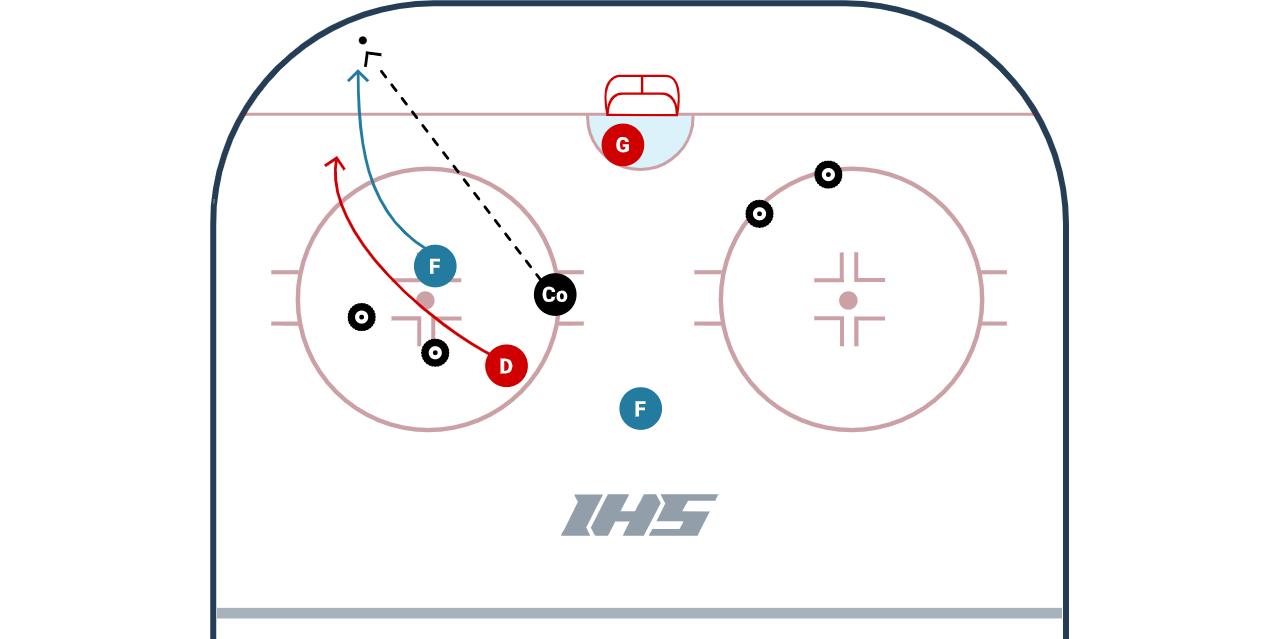
The Double Gates Activation Game from Coach Alyssa Gagliardi is a competitive small area game that starts out as a 1 on 1 and becomes a 2 on 1 after a player skates through one of the gates. This can also be modified to be a 2 on 2 that becomes a 3 on 2.
Setup
- Place a gate (gates can be made by tires, cones, etc) on each side of the net. This will create two gates and two options for the offensive player to skate though.
- Place one forward and one defender in one of the corners or circles.
- Place an additional player at the high slot or point.
- To start: a coach chips a puck in the corner to begin a 1 on 1 battle.
- The forward is trying to first skate through a gate. Once the forward skates through the gate, they are able to pass it to the open player at the point to begin a 2 on 1. The offensive team is trying to score a goal.
- The defender is trying to strip the puck during the 1 on 1 and/or the 2 on 1 and skate out of the zone.
- The coach can stop the play when there is a goal, the defender skates the puck out of the zone, the goalie freezes the puck or enough time has passed (15 - 30 seconds).
Coaching Points
- Offensive player:
- Look over your shoulder to see where the pressure is coming from.
- Do not expose the puck until you are ready to make a play. Use the net and the boards to protect the puck!
- Keep head up to be aware of where the gates are and the extra player is.
- Defending player:
- Work on taking a good angle.
- Keep your stick on the ice to go after the puck and to block passing lanes.
Game Variations
- Can allow the forward to immediately try to score a goal, or you can require them to first go through the gate before they can score. Either way, if they go through the gate the other forward is activated.
- Can set up gates in different areas of the ice.
- Can add gates at the blueline that the defense needs to skate through instead of skating over the blueline.
- Can start the game in different areas of the zone.
- Can setup the game in smaller areas of the ice (example - 1/4 ice instead of 1/2 ice.)
- Can be modified to be a 2 on 2 that becomes a 3 on 2 (diagram displayed below)
Can start this as a 1v1 or 2v2.
Corner to Half Wall 2 vs 1
The Corner to Half Wall 2 vs 1 is an excellent small area game for all age levels that helps players practice a 2 vs 1 in a small space along the boards in the corner of the ice. The game reinforces important skills like keeping your head up, moving to open spaces, protecting the puck, and verbal & non-verbal communication. Offensive players should practice using the boards to make bank passes.
The goal of the game is for the offense is to connect on 4 consecutive passes in a row. If they do so, they win and are allowed to shoot on net. If the defense takes the puck away, or the puck goes out of bounds 2 times during the game the defense wins and is awarded a shot on net.
Setup
- Playing Area: Use 4 cones or tires that create a triangle from the half wall to the corner that lines up with the inside post.
- Goalie Setup: This can be set up as a station with a goalie, or without. If you use a goalie they can be placed in the crease or the net can be moved to the point.
- Players: Alternate players. It is beneficial for players to get reps on both offense and defense sides.
- Passes: You can require 4 (or a different amount) of consecutive passes to win.
- Defense: If the defense is taking the puck away too much, you can tell the defense to flip their stick over.
- Winner: The winning side gets a shot on net. You can allow the winners to do a few options:
- If the offense wins:
- The last person with the puck gets a shot on net.
- Both players are given a puck and can shoot on different goalies.
- The game moves to a 2 vs 1 in front of the net and offense is allowed one shot if they can get it off.
- If the defense wins:
- They get a shot on net.
- The game moves to a 1 on 1 in front of the net and the defense is allowed one shot if they can get it off. The losing offense team needs to communicate with each other as to who is going to go after the defense.
- If the offense wins:
Coaching Points
- Use the boards! They are your friend!
- If used properly, the boards can be used as an extra player out there and are helpful for bank passes and puck protection.
- Offensive players need to protect the puck until they can make a play and then expose the puck to make a pass.
- Offensive players have to move without the puck. Think "Give & Go!" Go to open space!
- Defensive players are most successful with active sticks and stop and starts. There are no short cuts!
Progressions
- Require more consecutive passes.
- Make the game 2 vs 2.
- Create a smaller "playing area" to make it tougher on the offense.
- Move to the Point to Half Wall 2 vs 1 Game.
Related Links
3 Puck 3 On 3
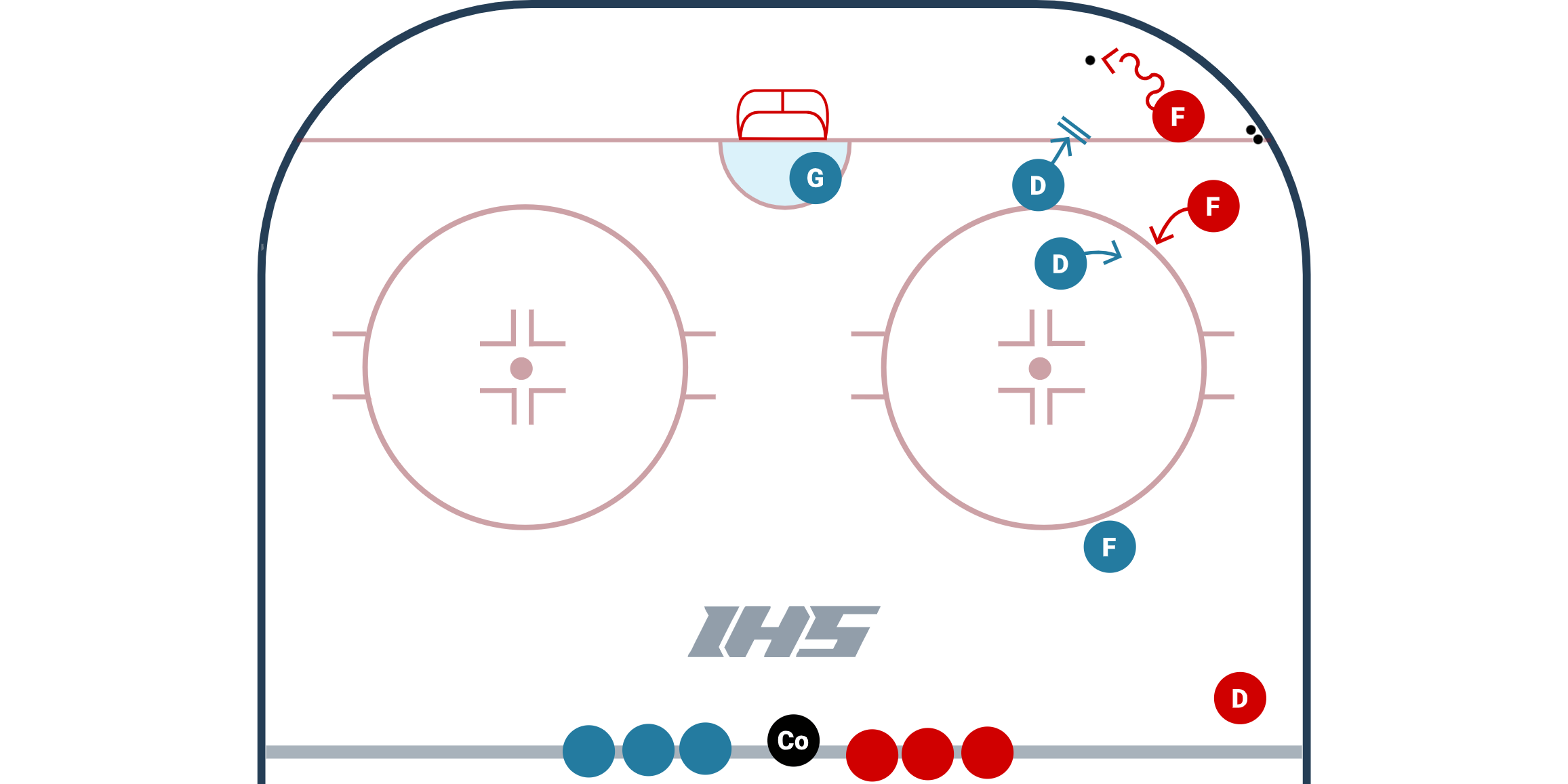
The 3 Puck 3 on 3 Drill from Ryan Donald is an excellent drill that helps players and teams work on defensive zone concepts like down low coverage and point coverage. In this drill, there are 3 whistles and 3 pucks that help create 3 unique in-zone situations. The details of the drill is listed below.
Setup:
- The players are set up in one-half of a zone as shown. There will be 2 forwards and one defenceman on the offensive team (red in the diagram above) and 2 defencemen and 1 forward on the defense (blue in the diagram above).
- A handful of pucks are in the corner close to the boards.
- Whistle # 1: on the first whistle, a 2 on 2 starts out of the corners. The players battle for 8 - 10 seconds as the forwards try to score a goal.
- Whistle # 2: on the second whistle, the forwards grab a new puck out of the corner and the defenceman at the point becomes active and so does the strong side winger that is covering the point. The defenseman at the point can move around but they must remain at the blueline. The players battle for another 8 - 10 seconds before the last whistle is blown.
- Whistle # 3: on the third whistle, the forwards retrieve a new puck out of the corner and the drill becomes a full on 3 on 3 because the defenseman at the point can now go anywhere they want to on the ice. The play can continue an additional 10-15 seconds until the forwards score, the defense breaks the puck out or the coach blows a whistle.
- Variations: You can allow the 3 on 3 to be played in the full zone, or you can wall off or cone off 1/3 of the zone (as pictured in the diagram) to force the players to only use one side of the ice.
Coaching Points:
- Defense:
- Defensemen: keep sticks on the ice and work to keep forwards contained in the corners.
- Strong Side Forward: keep stick on the ice to negate passes to the point. Scan the ice to see where the puck is and the point man is at all times.
- Forwards:
- Protect the puck and work to create time and space.
- Use the boards to bank a pass if no direct pass is available.
